
Teardown | First Impressions
Hayes Dominion A4 Brakes Ridden and Torndown
The Dominion A4 brake from Hayes is intended as their no-holds-barred, no feature spared, four-piston brake at the highest end of the performance spectrum. It started with an all-new platform with enough of a stylistic holler back to the original Hayes Mag G-1 to ring the ol' nostalgia bell for folks who traded up their v-brakes for the champagne stoppers.
The goal sounds bold but the Dominion has the lightest lever action of any brake on the market; a stated design goal from Hayes. Stripping the system down demonstrates how much thought has gone into their phoenix, almost twenty years since they were the Kleenex of disc brakes.

Beauty's in the eye of the bike owner; I love how the Dominion harks back visually to the first split-clamp champagne Mag G-1 brakes.

The Dominion A4 caliper is unapologetically massive and the system holds a lot of DOT-4 or DOT-5.1 brake fluid.
I have a lot of rides on the Dominion A4 brakes but I'm going to reserve deeper thoughts on their performance for the full review piece. Both Cam and I are on these brakes so we'll be combining efforts to provide two perspectives on the system.
Hayes had their development riders running other top systems to benchmark against their fresh brake and we'll be doing the same, comparing them with the latest four-piston brakes from Magura, Shimano, Formula, SRAM, and TRP.
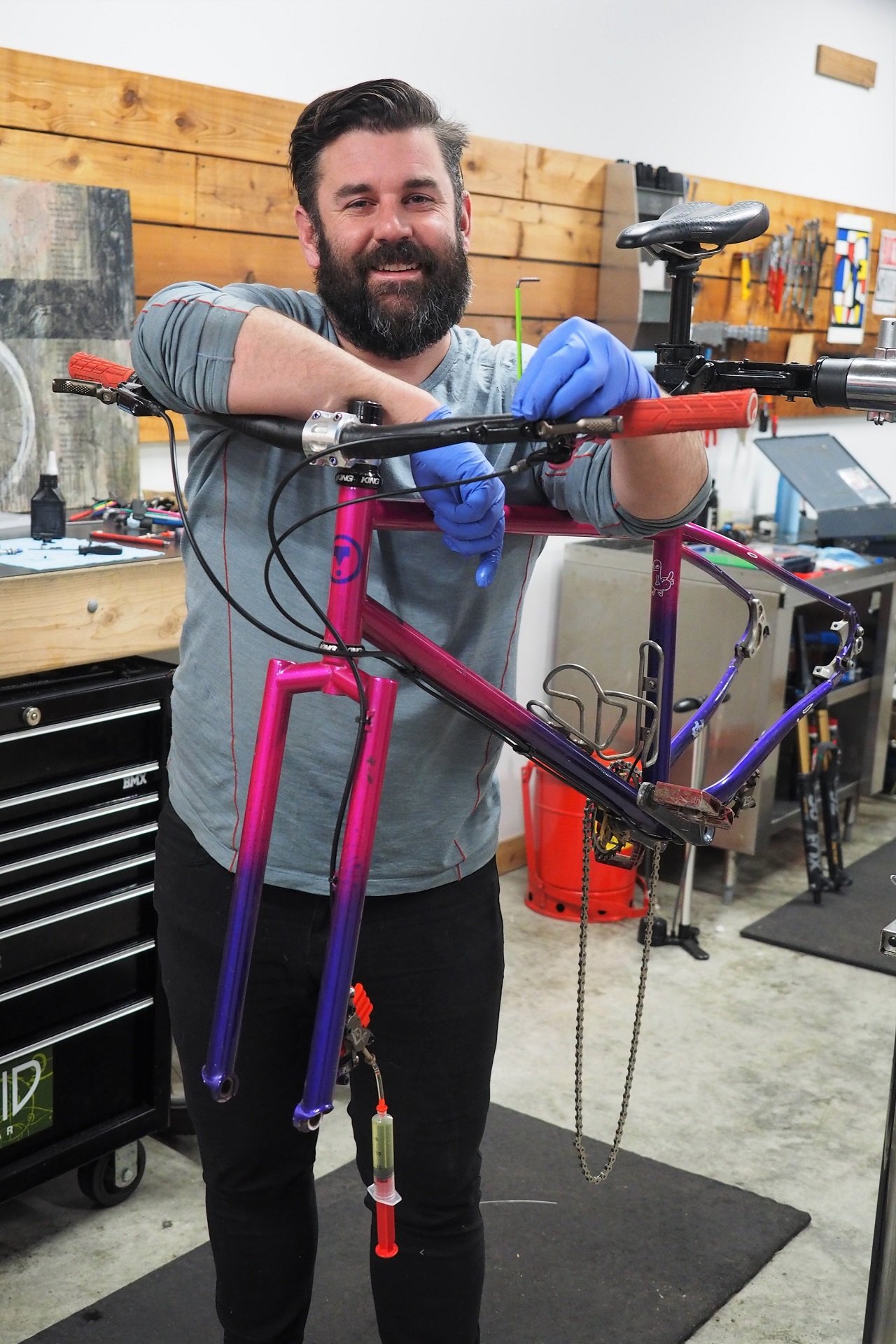
Jeff always smiles like this when we're working on DOT fluid brakes. They're his preference over mineral oil because of how they manage moisture.
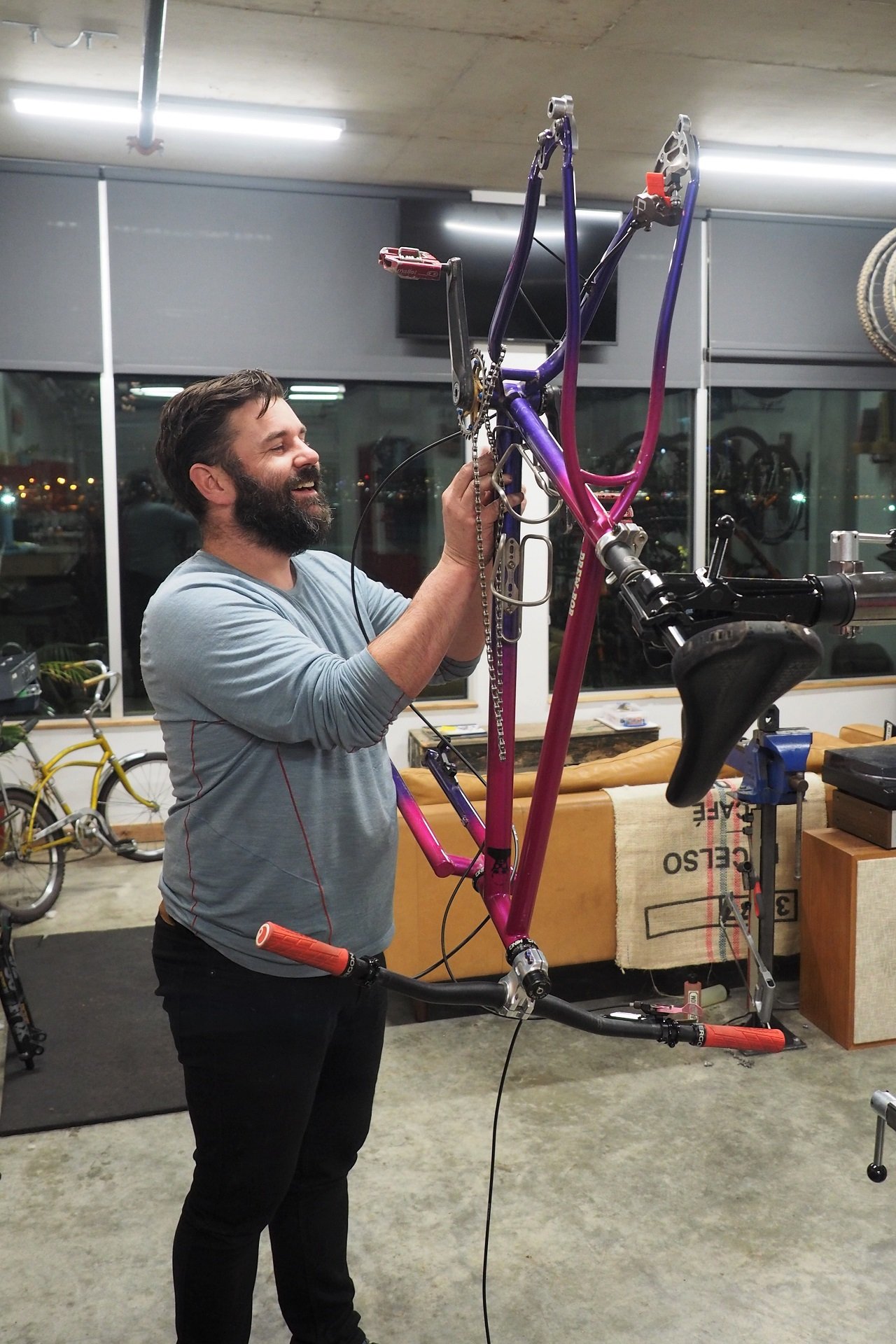
For the purpose of the review we used the factory spec DOT 5.1 but Jeff would usually prefer DOT 4, choosing moisture management over max boiling point.
Hayes Dominion A4 Brake Teardown
The Hayes bleed kit is really nice. Nice packaging, nice syringes, and nice fittings. Historically I've been a cheap syringe and piece of tubing attached to whatever fitting I need kind of guy, but between Formula and Hayes, I'm seeing things differently these days. I think the 55 USD outlay for the two nice syringes, fittings, and a 2oz container of DOT 5.1 is a fair investment for anyone who likes to stay on top of bleeding their brakes.
And, in terms of doing a teardown, opening up the reusable container is a solid first impression. So beers, cheers, and let's get cracking.

Thanks to Hayes, I am now of the opinion that every bleed kit should come in a reusable plastic container. Especially in an environment with both mineral oil and DOT systems.
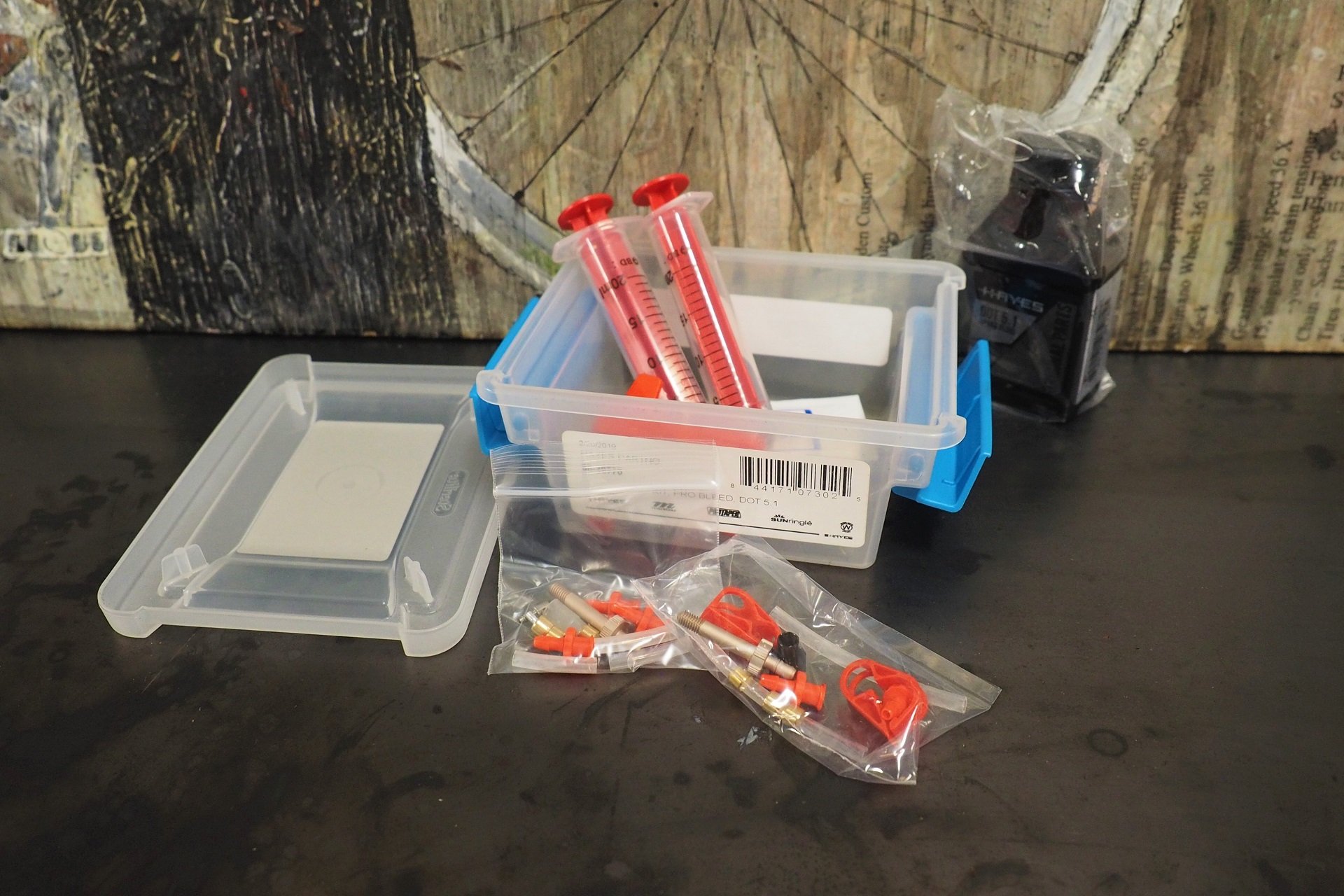
The Hayes bleed kit is really nice and comes with excellent syringes. I'd like to see a couple more spare fittings in there for 55 USD but that's me nitpicking.

I don't know if #ToolRollWars will ever overtake #ToolBoxWars in popularity but, being a bit starved for space, I'm seriously considering making the switch myself.
The master cylinders use ball bearing lever pivots, low friction piston seals, high-leverage at the blades, and lower internal pressures to all contribute to the aforementioned feathery lever action of the Dominion A4. It takes minimal force to get the pistons moving but there's a lot going into making that happen. Between the reservoir and caliper, the A4 holds a lot of fluid, which is great. Trying to save a tiny bit of weight or promote a sleeker design by limiting oil volume has always seemed really silly.
Aesthetically, the master cylinder is a case of beauty being in the eye of the bike owner and personally, I could do away with the gigantic lever reach adjuster, protected as it may be within the lever blade. It's very easy to use even with the thickest gloves but for a brake that's specifically designed to maintain consistent lever feel a 2.5mm hex key would be perfect.

The master cylinder uses the same bleed fitting as the caliper.

Massive volume, replaceable bladder, multiple ports.

Cartridge bearing pivot for smooth & silent action long term.

The ball joint-to-piston interface is solid but not hard mounted, so a crash won't damage the internals.

There is a dead stroke adjustment but I don't see anyone adjusting it away from the firmest, most positive, bitepoint. This setting has the screw all the way in, for the least deadstroke. (all the way towards the ‘-‘ symbol).

Low friction glide band (white) is yet another way Hayes has reduced friction in the system.
The massive master cylinder reservoir should mean that even the most maintenance-averse rider coming down Whistler on nothing but their brake pad backing plates, wondering what 'that squealing' is, won't have issues with air getting into the system. Likewise, there's a significant amount of brake fluid behind the pistons in the huge caliper which should effectively deal with heat, even without fancy two-piece rotors or finned pads.
On the subject of the calipers, don't be alarmed by the double bleed ports at the back. The Dominion A4 bleeds up just like a SRAM or Formula brake with a syringe at the master and a second at the caliper. If there are any issues getting a good bleed then the caliper can be bled from the other side (in case any bubbles are hiding there) and in a worst-case scenario, the caliper can be isolated and bled on its own. None of that was necessary here and even with the full teardown, Jeff bled both brakes up quickly without issues.

Don't fear the double bleed ports.

Adjustable brake line exit is convenient. Note the set screw at the caliper mount which Hayes calls Crosshair.

Four equally sized pistons.

The pistons and piston seals are all replaceable.

Massive machined path for fluid to travel through the caliper.
The caliper also features a set screw at each mounting hole which Hayes calls Crosshair and which is intended to help with drag-free setup. I could do without the extra holes being drilled in the caliper and didn't find the feature helpful or necessary for getting perfect drag-free performance. I also don't carry a 2mm hex key with me on the trail so if I did need to adjust the brakes for whatever reason the Crosshair would be a liability, not a feature. Not a big deal either way, just don't tighten it down, but food for thought regardless.
Also worth noting is that Hayes brake lines have a larger outer diameter than most. I took a cutting and it fits easily into every internally routed bike I've tried but, for example, I haven't put it in a Santa Cruz with in-molded routing, or a frame like an Intense with internal rubber lines.

The master cylinder and caliper use the same bleed fittings.

One syringe at each end just like SRAM and Formula.
Why DOT Fluid?
Other than a few trials riders who used to run water, Mineral oil and DOT fluid are the two choices when it comes to hydraulic fluid in brakes. You won't catch me drinking either but mineral oil, despite various additives, is generally considered much better for the environment while DOT fluid by nature of its use in automobiles is easy to properly dispose of and its effects on paint are massively overstated. They both manage moisture differently but this is a non-issue for anyone who services their brakes regularly. Simply put, a great braking system is a great braking system and while some riders certainly narrow their purchasing decision based on brake fluids, I'd guess that's a small minority.
When I first started working on disc brakes, Shimano and Magura were firmly in the mineral oil camp and Hayes, Avid (SRAM), Formula, and Hope all used DOT fluid. Most companies are still firmly entrenched but for their latest brakes - the Cura2 and Cura4 - Formula has moved to mineral oil. Hayes has also dabbled in mineral oil systems, particularly at the budget end of the spectrum, but their latest top stopper ships with DOT 5.1 and is also compatible with DOT 4.
Why? Hayes says that the choice to stick with DOT fluid for the Dominion A4 is an important factor in their achievement of a light lever feel and consistent bite point in all conditions.

The semi-metallic (bottom) pads are stock and the sintered-metallic (top) pads are an aftermarket option. Cam and I are riding both options.

This caliper is massive. Some frame & rotor combinations may not work where clearance is fine with a two-piston or even other four-piston calipers.
Cam and I will be back with a full on-trail review of our various Dominion A4 experiences before the year's out. For now, I'll say that I predict riders who buy this brake system will be very happy with it; it's refreshing to be able to say that about a Hayes brake. Like the new Manitou Mezzer fork, Hayes has released this product with plenty of allusions about how high their expectations are and no illusions about how badly these products need to be home runs.
TheDominion A4 lists for 230 USD per wheel. Please feel encouraged to ask any questions in the comments.






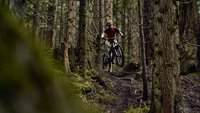


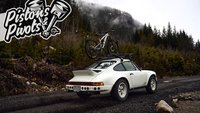
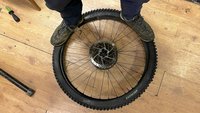
Comments
Shinook
4 years, 6 months ago
I've been on these about 4 months now and I came from the Code RSCs, I really really like them. They have a ton of power and some really nice, well thought out finishing details. They manage heat really well, I've roasted them on some long downhills to a surprising level of heat and they remained consistent. The rotors have stayed true and not warped, which is a problem I tend to have with SRAM rotors.
Personally, I found the Crosshair alignment system to be real useful, but I tend to have issues with my caliper shifting inwards over time for some reason. It also makes re-installation of the caliper a lot easier, since all you need to do is push it to the side. It wasn't a make or break feature for me, but I thought they were useful.
Another interesting feature that every other review has overlooked is the design of the bleed block. If you insert the opposite end of the bleed block into the caliper, it allows you to work the pistons out safely for lubrication. Every so often, you can push the pistons out safely (without risk of them popping out) using the block and drop some DOT onto the piston or clean it.
My only gripe is the bleed process, I found it a bit messier and more of a pain than the Code RSCs I came off of, but I think that's more of a case where Bleeding Edge is really good instead of the Hayes being problematic. It's also probably worth noting that most Shimano or SRAM adapters won't work due to the size of the caliper, so you have to get the Hayes one.
Mine came with both pad compounds, not sure if that changed or not. I run the metallic for the stopping power, especially with more aggressive tires, but both compounds feel really good. I tend to run my levers closer to the bar, so the metallics felt a bit better for me since the power comes down a lot faster. The resin felt really good, but wore a bit faster than I'd have liked and required a bit more lever pull to get the same power.
Looking forward to hearing your impressions, as well!
Reply
Andrew Major
4 years, 6 months ago
What did you fine was a barrier to using other brands’ adapters? My brakes came without and I’m running Magura ones front and rear with no issues.
Good point on the bleed blocks.
On the mess the secret is to unbolt the caliper so it’s the high point when removing/installing the bleed fittings. We had really clean bleeds front & rear although BleedingEdge is awesome (wrote about that previously).
As I said above, I knew my opinion on Crosshair wouldn’t be universal; I think when everyone who’s tried the brakes seems to love them to the point that the tiny setscrew in the calipers is the only point of schism that’s pretty awesome!
I have a ton to say about riding the brakes but didn’t want to get too far out in front since we’re doing the double review.
Reply
Shinook
4 years, 6 months ago
Interesting on the adapters, I forgot which brands I tried, I think it was Shimano, possibly a SRAM one as well. I didn't spend a ton of time making it work, either, I read online about issues with other adapters and preemptively bought one, although I did try other adapters out of curiosity.
The body of the caliper sortof bulges down a bit more and it hits the adapter, which prevents you from bolting it down. I guess saying you must use theirs is a bit of an absolute that isn't really true since I didn't try a lot of other sizes or brands, just what I had laying around. I had read similar complaints online from others trying to use other adapters, but I'm not sure what they were using. I'll double check later and see which brands I tried.
That's a good idea on removing the bleed fittings, I'll have to try that next time.
Reply
Andrew Major
4 years, 6 months ago
In my case it’s a good thing other adapters work - not a lot of companies still offering IS to 203mm PM front adapters!
Reply
ChazzMichaelMichaels
4 years, 6 months ago
Call me ignant, but who makes forks with IS mounts? I've only ridden Manitou and Rockshox in the last ten years.
Reply
Andrew Major
4 years, 6 months ago
The bike in all the photos in this article has a fork with IS mounts!
Tadpoledancer
4 years, 6 months ago
I’m kinda surprised that you don’t appreciate the sideways adjustability of the callipers. Seems like a pretty nice functionality to me that would save some time when setting up.
Reply
Andrew Major
4 years, 6 months ago
I knew that would be the most contentious differing of opinions between folks who’d setup the brakes. It’s not for me but it’s there for anyone who likes it.
Reply
Andrew Major
4 years, 6 months ago
This comment has been removed.
materials-guy
4 years, 6 months ago
$55 US for the bleed kit seems a bit much.
Go to Aliexpress and get a rebuildable pro syle kit with various fittings for < than half the price.
Just look for the kit with metal fittings and not the plastic ones.
They, in my opinion are the best out there for the price, bar none.
Reply
Applesauce
4 years, 6 months ago
Interesting take on the superiority of DOT fluid stemming from its inherent, essential propensity for water absorption.
Any idea why Hayes has (almost) always put the reservoir UNDER the MC bore? Despite the counterintuitive placement of the reservoir and bore ports, they’ve always seemed to work anyway. But I’d love to know the design. When the rep came to my shop he seemed not to understand the question at all...
Reply
Andrew Major
4 years, 6 months ago
It's an interesting observation but I think once you account for lever positioning (in use) many reservoirs or at least the intake/return port are below the bore (in usage). Maybe less so now that everyone seems to be French. As you say, Hayes has always been this way.
I've never heard of it being an issue with Hayes but I know some older Magura brakes really didn't like to be run in a more perpendicular position especially with the pads near end of life. That could also come down to reservoir size.
What Jeff noted that Hayes has always done but other bike companies don't do is the multiple intake/return ports which are more common in other applications for which Hayes manufactures brake systems.
...
This is stretching/extrapolating my first-hand knowledge (I'm not a mountain bike historian - and I'm always ready to be corrected/enlightened) but looking at the first hydraulic disc braking systems on the bicycle market with the exception of Hayes they were derived from brakes for mopeds. In that statement, I'm including Magura (Gustav), Formula, and Grimeca - Italian companies making moped brakes - and also Shimano and SRAM (not Avid) whose systems had way too much in common with Grimeca brakes to be a coincidence. Hope also had interchangeability with Grimeca - pads for sure and I can't recall for certain if there were other parts - and Formula manufactured the first Avid Juicy brakes.
On the other hand, Hayes has long make brakes for heavy industrial equipment with a sideline doing systems for Harley Davidson motorcycles so I'd say while the basic principles of hydraulic brakes are the same they were maybe coming at it from a different space than other companies that could/did largely adapt existing products.
Reply
AndrewR
4 years, 6 months ago
Who made Jeff's tool roll for him please?
Reply
Andrew Major
4 years, 6 months ago
I should know this but I have to confirm with Jeff. He’s both a magnet for cool old stuff (particularly SnapOn tool boxes) and surprisingly handy so there’s a chance it belonged to someone’s great grandpa and there’s also a chance he made it.
Reply
Andrew Major
4 years, 6 months ago
Jeff says he found it on ETSY. He does have an excellent eye for nice things.
Reply
Garrett Thibault
4 years, 6 months ago
After seeing the price, I'm now curious why there's all this hype for the new Hayes? They're priced pretty close to the Code RSC, and far above the Code R.
Reply
Shinook
4 years, 6 months ago
They're on par with the Code RSC in terms of features. They both are well designed, both use bearings in the lever instead of bushings, both have reach/contact adjust, both are rebuildable, and both feel great, although a bit differently.
As for the Code R, I can't run any of the R/RS level SRAM brakes. Every pair I've had developed an annoying amount of lever flop due to the bushing in the lever.
The main difference for me between the Code RSC and the Dominion A4s I've been running is the lever feel. The Codes seem to have a firmer, more immediate 'firm' feel on the lever stroke without any slack than the Dominions. That said, the Codes power seems to come in a bit slower and more modulated, whereas the Dominions comes in a bit faster once it starts to engage. IMO the Dominions have more power than the Codes do, but if you run the levers far out on the Codes, you might be able to get the same amount of power, it just takes more of a pull from your hand. The lever throw on the Dominions is definitely the smoothest and requires the least amount of hand strength to achieve power than other brakes I've used.
The only area I preferred the Codes was bleeding, Bleeding Edge is a bit easier to work with. That said, the Hayes have some nice features the Codes lack, like the ability to flush the caliper, ease of alignment, and ease of lever maintenance.
Reply
Andrew Major
4 years, 6 months ago
I’d echo this. SRAM’s bleed system is still the best but otherwise the A4 is at least the equivalent of the RSC. I think you’ll see the Dominion popping up on more bikes so probably won’t be long before a curious rider can squeeze some levers.
Reply
Jerry Willows
4 years, 6 months ago
thanks.... good insight. What is lever flop? I have Code R's and curious.
Reply
Shinook
4 years, 6 months ago
I had several sets of Guide R and RS levers develop up/down lever flop, where the lever has a considerable amount of vertical play. You could grab the lever and push it up/down a fair bit, it eventually got bad enough that I could feel it while riding. I had a similar experience with Shimano brakes, although to a lesser degree.
I can't say if the Code Rs suffer from the same problem, the lever is a bit larger, so maybe the bushing in there wears better than the Guides. I just typically prefer bearings in the lever to avoid this becoming an issue.
Reply
Heathen
4 years, 6 months ago
I can confirm the Code R develop the same lever flop.
Reply
ChazzMichaelMichaels
4 years, 6 months ago
Consider me chastised. I thought that bike was just a prop!!
Reply
Andrew Major
4 years, 6 months ago
No worries and no way - long & slack rigid bikes are the future (Hahahahahaha)
Reply
danimaniac
4 years, 4 months ago
This comment has been removed.
danimaniac
3 years, 11 months ago
Question here... Your say you cannot see anyone using the brakes dead stroke adjustment away from full +.
Their own YouTube tutorial/ installation video says they are delivered tuned for minimum dead stroke in full minus..
What does the screw really change? Dead stroke? Bitepoint? I'm totally clueless now after looking at it for a while....
Reply
Andrew Major
3 years, 11 months ago
Maybe it's more clear to say that they come pre-set with the minimum amount of dead stroke. Put another way, they come with the dead stroke tuned to the firmest/fastest engagement option and I can't see anyone actually adjusting that after riding the brakes.
If someone preferred a mushier feeling brake engagement (some folks do) they could adjust in more dead stroke but Dominion is so different out of the box in terms of how light action they are that there's a brief learning curve anyways and even if someone is used to less crisp action now I actually don't think anyone would adjust the dead stroke after experiencing the brakes.
Hope that's helpful.
Reply
danimaniac
3 years, 11 months ago
somehow not... but I'm really feeling stupid right now :D
What does that screw indicated with + and - really do? (not the reach adjust) Does it adjust bitepoint or deadstroke? In the german forum mtb-news.de/Forum a guy claims that the bitepoint can be adjusted using that screw.. Am I actually missing something?
There's this picture on pinkbike where I'd understand it in a way, that there is another screw "hidden" away in the assembly of the push-rod.
did I say I feel stupid right now?
Reply
Andrew Major
3 years, 11 months ago
Bitepoint, deadstroke, some people call it freestroke - some people write them as one word (e.g. deadstroke) and some people write them as two words (e.g. dead stroke) - they're all the same thing.
I'm not clear on what you are trying to figure out or accomplish exactly? I'd like to help if I can.
I've yet to communicate with a person riding the Dominion who has wanted to increase the deadstroke on this brake (I myself didn't touch the adjustment) and that includes the folks I talked to at Hayes. But I suppose if you want more lever float before engagement or you want to micro-adjust your lever feel front v. rear the option is there.
Personally, I think it's easiest to think of a factory setting, adjust lever reach, and go ride.
Reply
danimaniac
3 years, 11 months ago
Pinkbike says that the dead/freestroke adjustment is hidden away and secured by a grub screw. Then there's also the round-head screw with + and minus written to it, right?
I really need to take a very close look when I'm back home and take a look at my bike.
In which direction do you have that screw screwed in (all the way)? In the teardown the description of the pic says you cannot see anyone use it away from Full Plus. Hayes says in their youtube tutorial that it is factory set at full minus...
I'm totally confused right now :D
If you'd like to dig deeper or clarify further we can absolutetly go to PM and just present result here (to whom that may concern)... ;-)
Reply
Andrew Major
3 years, 10 months ago
Nope, I figured it out.
“Full +” as in full on as in firmest bite point is actually all the way towards the tiny ‘-‘ symbol (presumably - for least deadstroke). I have updated the caption.
Had not even noticed the tiny symbol during full teardown, so I apologize for the confusion.
That is the only “hidden” adjustment. ~ All way screwed in (~ all the way -) is where the brakes come set and where everyone I know runs them.
Which also happens to be the most positive engagement.
As with all adjustable bike parts, I’d recommend experimenting to find your best setup.
Cheers,
danimaniac
3 years, 10 months ago
Thanks! This is what I found to be it in the garage now after work, too. Could not find any other adjustment or anything as well.
Confusion gone,about this at least. And for now ;)
Have a great day!
Reply
Please log in to leave a comment.